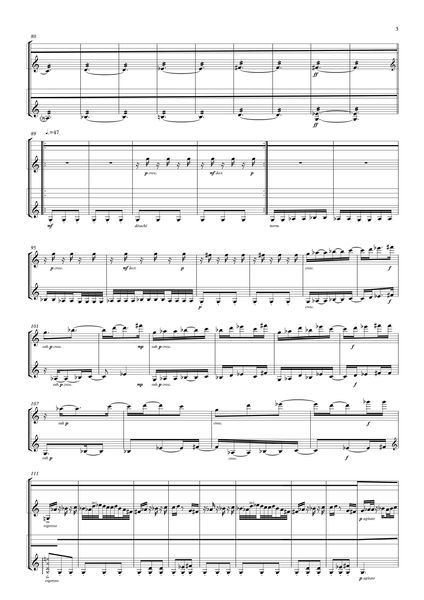TETRADEC (2020)
Instrumentation: two violins
Originally composed under a different title for the Twiolins’ 2019 Progressive Classical Music Award.
A piece that has left rather a lasting impression on me is Frederic Rzewski’s The People United Will Never Be Defeated! (see I Look Up As I Walk and Equinox). Though as a whole it is a kind of godsend in the form of a catalogue of piano and compositional techniques, I took a particular liking to the octave-displacement technique used in the first variation. Since Equinox remained partially unfinished and lacked much in the way of harmonic interest, I had a desire to return to this idea and hocketing I used in that same piece and do it properly.
This is one that will appeal most to people with at least a passing interest in maths, but the basis here the sieve theory that Iannis Xenakis explored potential musical applications of (Mists was the piece world-leading Xenakis scholar and all-round fascinating chap Dimitrios Exarchos tried very gently to help us get to grips with, though there was an attempt to expose us to mind-bending complexity of Nomos Alpha as well). Since I can’t pretend to have even a rudimentary understanding of the actual intended applications of sieve theory, suffice it to say that Xenakis used it to create scales. From there, a number of procedures are possible that yield interesting transformations of the scale. The aspect of it that caught my attention was the fact that under this system scales do not need to be confined to the twelve-note octave; rather, you could have, for example, a scale (technically a sieve, but the difference doesn’t matter too much for the sake of this explanation) whose sequence repeats after fourteen notes. Or you could have one that repeats after eighteen notes, or twenty-eight notes, or a hundred and forty-seven, or whatever. This base value is referred to as the modulus, or M.
Once you abandon scales that repeat at the octave, you encounter ones whose pitches never repeat or repeat beyond the octave (imagine writing out the numbers 1 to 12 on paper over and over again in a straight line. If you were to take every third note, for example, you would get a sequence of numbers that repeats every time you reach 1, since 12 is divisible by 3. Now imagine taking every fifth note—twelve does not divide by five, so the sequence you obtain would repeat only after sixty values. That’s the kind of thing happening here). Work on this piece began with a loose inquiry into what I could do musically if I took as my starting material a series of sieves of gradually increasing M value. With careful and considered choices I could produce scales into which pitches outside of my starting scale begin to appear as the scales increase in span (‘span’ here being analogous to the octave in what we would term a conventional scale, i.e. the number of chromatic pitches beyond which the scale’s intervallic sequence repeats).
What really takes this concept to intergalactic levels of cool and really made it something that Mammas my Mia though is the following statement. Get ready for this: the same system that generates scales and pitches can also be used to generate rhythmic, articulation and dynamic material. That is to say, you can have a set of pitches that contain within them instructions to create a rhythm or any other musical parameter for that matter. Now that’s what I call organicism. You can have a melodic line and a rhythm and a series of dynamic changes that are borne of the same DNA, a fact that allowed me to serialise every aspect of the composition in a way similar to that Messiaen established in Mode de valeurs et d'intensités. The difference, I believe, is that this system is more flexible and efficient since the transformations it is possible to make to each sieve are more wide-ranging and the consequences for the resulting integer sequence fairly easy to translate into music once familiarity with it has been acquired.
My actual compositional techniques are outlined in more detail in my commentary, but my aim was to build a structure that mirrored the development of my material in some way, and to that end each section is greater in proportion and complexity than the last, just as the sieves increase likewise. I anticipate it would be particularly thrilling to listen to as I have shared the melodic line between the two instruments and it becomes audible at the end of each section as they ‘lock in’ after completing individual cycles that serve to obscure it. In another act of self-plagiarism, the piece opens in the same way as Plight and MONO: with that unison that one instrument glissandos out of to form the minor second signals to everybody that I think rather highly of myself for my ability to draw everything that follows from this single compositional decision.












